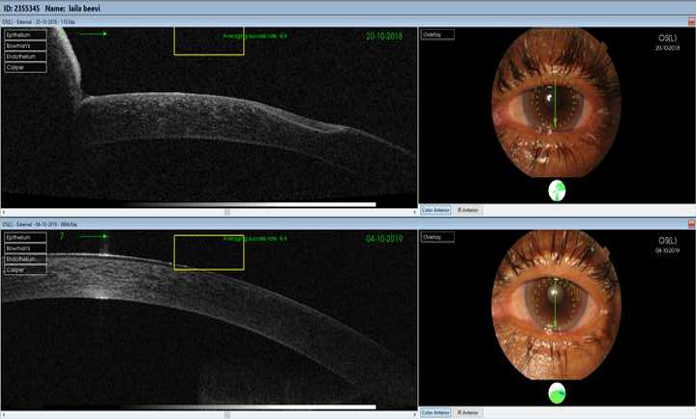Introduction
Sjogren’s syndrome is an autoimmune disease characterized by lymphocytic infiltration and destruction of lacrimal glands, salivary glands and other exocrine glands leading to classical triad of keratoconjunctivitis sicca, xerostomia and parotid gland enlargement. Involvement of other exocrine glands results in dry skin, nose, throat, trachea and vagina. This is classified as primary and secondary. Primary exists in isolation whereas secondary Sjogren syndrome is associated with other systemic autoimmune disease.1 Most widely accepted criteria for diagnosis of Sjogren's is American-European Consensus Criteria for Sjogren’s Syndrome 2 (Table 1). 3
Secondary Sjogren’s is most commonly associated with rheumatoid arthritis, but can be associated with other autoimmune disorders also. Rheumatoid arthritis is also an autoimmune disorder presenting with symmetrical inflammatory polyarthritis, joint stiffness and constitutional symptoms. Females are affected more commonly. Rheumatoid arthritis is diagnosed using ACR classification criteria. 4
The exact cause of dry eye in Sjogren’s syndrome is unknown. but it is considered as a result of T cell mediated inflammatory destruction and inflammatory mediators related increased apoptosis of lacrimal glands causing severe dry eye. In addition, peripheral nerve dysfunction in cornea also contribute to dry eye since sensory nerves in cornea and conjunctiva is the afferent branch of lacrimal reflex arc.
Dry eye syndrome is a state of front of eye in response to damage to normal tear coating of it. In Sjogren’s there is lacrimal gland destruction leading to aqueous layer deficiency dry eye. Severe dry eye can cause photophobia, corneal melting, infection, ulcers and even perforation.
Treatment of Sjogren’s syndrome is mainly focused on symptomatic management of dry eye. Since it is an autoimmune disease, immunosuppressant treatment can be of some help in improving symptoms in Sjogren’s syndrome. Here we report a case of advanced secondary Sjogren’s and the effect of systemic immunosuppressant in the severity of corneal thinning and other ocular manifestations during a follow up period of 1 year.
Figure 1
Left eye showing conjunctival and circumcorneal congestion with filamentary keratitis and corneal thinning

Table 1
American-European Consensus Criteria for Sjogren’s Syndrome.3
Case History
A 62-year-old female patient admitted for bilateral parotitis was referred to ophthalmology department with history of pain and foreign body sensation in both eyes. She was already on treatment for filamentary keratitis both eyes and cornealulcer left eye with impending perforation from a local hospital for more than 3 months (topical antibiotic preparation and lubricant eye drops. She gives history of using bandage contact lens 2 weeks back). She gives history of chronic joint pain for 10 years, morning stiffness in small joints and dryness of mouth.6 On examination there was severe localised corneal thinning of size 4x4 mm in the pupillary region extending upto midstroma left cornea with multiple filaments both cornea along with conjunctival and circum corneal congestion (Figure 1). Shirmer test values were 2 mm both eyes.7 Corneal staining score was 11 in right eye and 13 in left eye according to NEI/Industry Grading system.8 Anterior chamber was quiet and fundus normal. Systemic examination showed bilateral parotid enlargement. RA factor and anti CCP antibody were positive confirming secondary Sjogren’s according to revised International classification criteria for Sjogren's syndrome and ACR criteria for rheumatoid arthritis. She was initially started on topical lubricant eye preparations and later topical immunosuppressant (cyclosporine) was also added. Even though there was no clinical improvement, she was symptomatically better. She was then referred to rheumatologist for arthritis management and started on systemic HCQS, methotrexate and methyl prednisolone. Patient showed a drastic symptomatic relief of both systemic and ocular symptoms after starting systemic immunosuppressants. Corneal thinning improved clinically within1 month, confirmed with anterior segment OCT.
After 5 months, with improvement in arthralgia, systemic medications were tapered; then all of a sudden, she presented with worsened ocular symptoms and corneal thinning, forced us to step up the treatment. She was followed up for a period of 1 year and is presently under remission with systemic methotrexate, hydroxychloroquine, methyl prednisolone, topical cyclosporine and lubricant eye drops (Figure 2).
Figure 2
AS OCT showing improvement in corneal thinning with systemic immunosuppressants in secondary sjogrens syndrome

⁎ NEI – national eye institute.
† Anti CCP antibody- Anti Cyclic Citrullinated Peptide antibody.
‡ AS OCT- Anterior Segment Optical Coherence Tomography.
Discussion
Sjogren’s was clinically described at first by Mickulicz in a 42-year-old man with bilateral parotid and lacrimal gland enlargement in1892. It is a chronic inflammatory disorder characterized by exocrine gland dysfunction and results in sicca complex – dry eyes, dry mouth, dryness in skin, throat, nose, trachea/vagina. Some may develop systemic complications like dysfunction of heart, lungs, liver, renal system, nervous system, muscles, joints, skin, vasculature and blood. Severe dry eye can cause corneal scarring, ulceration, infection, and even perforation. pathogenesis of Sjogren's is complex and uncertain, but similar to benign lymphoepithelial lesion. 10% undergo lymphoma transformation because of lymphocytic infiltration. 7 Differential diagnosis includes adult blepharitis, dry eye syndrome, juvenile idiopathic arthritis uveitis and keratopathies. Treatment depends on extend and severity of clinical presentation and through multidisciplinary approach -maintaining integrity of tear film through preservation, augmentation and / replacement of tear. Systemic immunosuppressant agents like methotrexate, antimalarials, cyclophosphamide, TNF alpha antibody (infliximab) may be used to improve tear production in recalcitrant Sjogren's. Topical cyclosporin A is approved by US FDA as a treatment for dry eye.
In our present case, patient was followed up for a period of 1 year after initiation of systemic immunosuppressant in addition to topical cyclosporine and lubricant eye drops and found to have significant improvement in ocular manifestation.
⁎ US FDA- united states food and drug administration.
